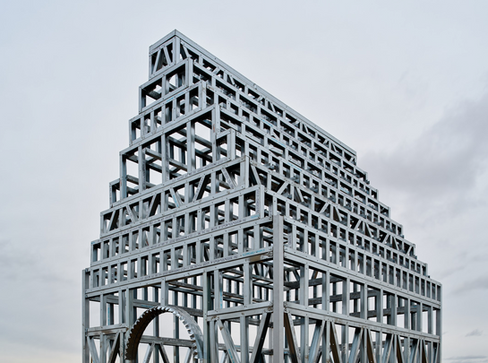Temple of the Labourers: An Ode to the Unsung Hands Behind Great Architecture
- Hinton Magazine

- Jun 18
- 2 min read
In a quiet open field on the outskirts of Suzdal — one of Russia’s oldest and most picturesque cities — a striking skeletal form interrupts the horizon. At first glance, it could be mistaken for the unfinished framework of a house. But look a little closer, and you’ll find a powerful artistic statement — a graceful lattice of metal ribs that carries the weight of centuries of forgotten craftsmanship. This is Temple of the Labourers, a new architectural installation by Russian practice Le Atelier, honouring the silent hands that have shaped the built world.

While the names of iconic architects echo through time — from Imhotep in ancient Egypt to modern masters revered globally — the vast majority of those who physically manifest these visions remain forever anonymous. The stonemasons, plasterers, carpenters and painters who translate lines on a page into living, breathing spaces are rarely credited. Temple of the Labourers sets out to correct that imbalance.
Constructed from drywall profiles — the very framework typically hidden behind finished walls — the structure’s materiality is part of its message. It uses the same unseen elements that are quietly responsible for most modern interiors. These profiles, provided by Knauf, are arranged with precision and elegance, but remain proudly exposed, embodying both the invisibility and the indispensability of labour.
Rooted in research into suburban vernacular architecture, Le Atelier’s installation reflects an architectural language formed outside professional practices — organic, improvisational, and deeply human. The piece is nearly waste-free, constructed in harmony with the very ethos of the rural Russian landscape that surrounds it.
Its setting is no less significant. Situated beside the village of Menchakovo in the Suzdal district of the Vladimir region, the Temple rises from a landscape rich in cultural heritage. Nearby Suzdal, founded in 1024, is a city steeped in history, while Menchakovo itself dates back to the late 18th century. Today, the village is enjoying a subtle renaissance, where thoughtful tourism meets the contemporary arts. It’s a place where past and present coexist — where wooden homes are restored with care and new structures emerge with respect for their context. Dotted throughout the area are installations by leading modern artists and designers, of which Temple of the Labourers is now a standout addition.

Architects Sergei Kolchin and Natalia Senyugina of Le Atelier have created not just a building, but a gesture — one that asks us to pause and consider the silent majority behind every celebrated architectural feat. In its form, its materials, and its location, the Temple is both a tribute and a question: how do we honour those who remain in the shadows, even as their work surrounds us every day?
.png)
_edited.jpg)
















Comments